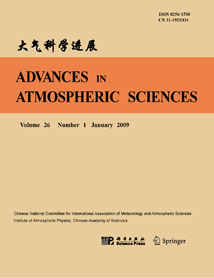| [1] |
MIAO Yucong, LIU Shuhua, CHEN Bicheng, ZHANG Bihui, WANG Shu, LI Shuyan,
2013: Simulating Urban Flow and Dispersion in Beijing by Coupling a CFD Model with the WRF Model, ADVANCES IN ATMOSPHERIC SCIENCES, 30, 1663-1678.
doi: 10.1007/s00376-013-2234-9
|
| [2] |
Liu Shida, Liu Shikuo, Xin Guojun, Liang Fuming,
1994: The Theoretical Model of Atmospheric Turbulence Spectrum in Surface Layer, ADVANCES IN ATMOSPHERIC SCIENCES, 11, 408-414.
doi: 10.1007/BF02658160
|
| [3] |
JIANG Yujun, LIU Huizhi, SANG Jianguo, ZHANG Boyin,
2007: Numerical and Experimental Studies on Flow and Pollutant Dispersion in Urban Street Canyons, ADVANCES IN ATMOSPHERIC SCIENCES, 24, 111-125.
doi: 10.1007/s00376-007-0111-0
|
| [4] |
Jae-Jin KIM, Do-Yong KIM,
2009: Effects of a Building's Density on Flow in Urban Areas, ADVANCES IN ATMOSPHERIC SCIENCES, 26, 45-56.
doi: 10.1007/s00376-009-0045-9
|
| [5] |
M. Y. Totagi,
1994: Power and Cross-Spectra for the Turbulent Atmospheric Motion and Transports in the Domain of Wave Number Frequency Space: Theoretical Aspects, ADVANCES IN ATMOSPHERIC SCIENCES, 11, 491-498.
doi: 10.1007/BF02658170
|
| [6] |
Jae-Jin KIM, Jong-Jin BAIK,
2010: Effects of Street-Bottom and Building-Roof Heating on Flow in Three-Dimensional Street Canyons, ADVANCES IN ATMOSPHERIC SCIENCES, 27, 513-527.
doi: 10.1007/s00376-009-9095-2
|
| [7] |
Jang-Woon WANG, Jae-Jin KIM, Wonsik CHOI, Da-Som MUN, Jung-Eun KANG, Hataek KWON, Jin-Soo KIM, Kyung-Soo HAN,
2017: Effects of Wind Fences on the Wind Environment around Jang Bogo Antarctic Research Station, ADVANCES IN ATMOSPHERIC SCIENCES, 34, 1404-1414.
doi: 10.1007/s00376-017-6333-x
|
| [8] |
Ning ZHANG, Yunsong DU, Shiguang MIAO,
2016: A Microscale Model for Air Pollutant Dispersion Simulation in Urban Areas: Presentation of the Model and Performance over a Single Building, ADVANCES IN ATMOSPHERIC SCIENCES, 33, 184-192.
doi: 10.1007/s00376-015-5152-1
|
| [9] |
HU Wei, ZHONG Qin,
2010: Using the OSPM Model on Pollutant Dispersion in an Urban Street Canyon, ADVANCES IN ATMOSPHERIC SCIENCES, 27, 621-628.
doi: 10.1007/s00376-009-9064-9
|
| [10] |
MIAO Yucong, LIU Shuhua, ZHENG Hui, ZHENG Yijia, CHEN Bicheng, WANG Shu,
2014: A Multi-Scale Urban Atmospheric Dispersion Model for Emergency Management, ADVANCES IN ATMOSPHERIC SCIENCES, 31, 1353-1365.
doi: 10.1007/s00376-014-3254-9
|
| [11] |
Zhong Shiyuan, Zhou Mingyu, Li Xingsheng,
1987: A NUMERICAL STUDY ON THE MESO-SCALE POLLUTANT DISPERSION OVER A SLOPED SURFACE IN THE STABLE BOUNDARY LAYER, ADVANCES IN ATMOSPHERIC SCIENCES, 4, 300-312.
doi: 10.1007/BF02663600
|
| [12] |
Jiang Weimei, Yu Hongbin,
1994: Study on the Thermal Internal Boundary Layer and Dispersion of Air Pollutant in Coastal Area by Numerical Simulation, ADVANCES IN ATMOSPHERIC SCIENCES, 11, 285-290.
doi: 10.1007/BF02658147
|
| [13] |
Li Xin, Hu Fei, Pu Yifen, M.H.Al-Jiboori, Hu Zhaoxia, Hong Zhongxiang,
2002: Identification of Coherent Structures of Turbulence at the Atmospheric Surface Layer, ADVANCES IN ATMOSPHERIC SCIENCES, 19, 687-698.
doi: 10.1007/s00376-002-0008-x
|
| [14] |
Li Xin, Hu Fei, Liu Gang, Hong Zhongxiang,
2001: Multi-scale Fractal Characteristics of Atmospheric Boundary-Layer Turbulence, ADVANCES IN ATMOSPHERIC SCIENCES, 18, 787-792.
|
| [15] |
Chen Wuhe, Situ Da, Zhong Xubin,
1998: Atmospheric Refractive Turbulence Effect on Diffraction-Limited Infrared Coherent Lidar, ADVANCES IN ATMOSPHERIC SCIENCES, 15, 124-134.
doi: 10.1007/s00376-998-0024-6
|
| [16] |
Xiao Jingwei, Lu Naiping, Zhou Mingyu,
1985: APPLICATION OF SODAR SOUNDING TO ATMOSPHERIC DISPERSION-MIXING DEPTH AND CONCENTRATION AT THE GROUND, ADVANCES IN ATMOSPHERIC SCIENCES, 2, 63-71.
doi: 10.1007/BF03179738
|
| [17] |
Liu Shikuo, Huang Wei, Rong Pingping,
1992: Effects of Turbulent Dispersion of Atmospheric Balance Motions of Planetary Boundary Layer, ADVANCES IN ATMOSPHERIC SCIENCES, 9, 147-156.
doi: 10.1007/BF02657505
|
| [18] |
Wang Tijian, Li Zongkai, Sun Zhaobo,
1998: Study on Conventional Atmospheric Dispersion Models in China, America and Canada, ADVANCES IN ATMOSPHERIC SCIENCES, 15, 523-530.
doi: 10.1007/s00376-998-0029-1
|
| [19] |
Ning ZHANG, Yunsong DU, Shiguang MIAO, Xiaoyi FANG,
2016: Evaluation of a Micro-scale Wind Model's Performance over Realistic Building Clusters Using Wind Tunnel Experiments, ADVANCES IN ATMOSPHERIC SCIENCES, 33, 969-978.
doi: 10.1007/s00376-016-5273-1
|
| [20] |
Xiang Kezong,
1988: THE CELL-MOVE-EXPANSION MODEL FOR THE EVALUA-TION OF GROUND LEVEL POLLUTANT CONCENTRATION, ADVANCES IN ATMOSPHERIC SCIENCES, 5, 325-334.
doi: 10.1007/BF02656756
|















 AAS Website
AAS Website 
 AAS WeChat
AAS WeChat 
 DownLoad:
DownLoad: